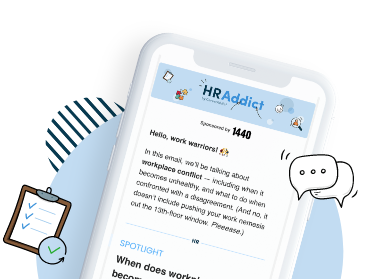According to DDI’s Frontline Leader Project, more than half (57%) of employees quit their jobs because of their boss or manager. A survey by Gallup, meanwhile, has shown that around 50% of employees don’t understand what’s expected of them at work — which also negatively impacts their engagement, making them likelier to leave.
Luckily, the way you give out feedback to team members can address both these pain points, strengthening your relationship to them while giving them a clear idea of what they should be doing. In a nutshell, that’s constructive feedback!
In this article, we’ll be discussing the benefits of constructive feedback in more detail and sharing 10 examples that can help you phrase your comments and suggestions in a way that encourages employee growth most effectively.
The importance of feedback
In simple terms, constructive feedback combines comments (even hard-to-deliver ones) with actionable guidance, allowing you to add a positive spin to your message — even when you’re displeased about a situation. When your feedback has a positive, future-facing undertone, your employees are less likely to fixate on their mistake(s) and more likely to start taking steps to improve.
As an employer or leader, this works in your favor. Boosting your employees’ sense of self-efficacy and not escalating a tense situation further can preserve their productivity and confidence, allowing them to remain productive and avoid similar mistakes in the future.
Examples of constructive feedback
In this section, we share 10 instances in which managers are called to provide constructive feedback, which you can use as inspiration when approaching your employees.
1. Your employee’s performance is decreasing
Although it’s normal for employee performance to fluctuate, if someone’s performance seems to drop and stay low, you will have to address it. Besides pointing out the change you’ve observed, try to find out what’s behind it.
EXAMPLE FEEDBACK
Steve, you have been one of our most reliable staff members ever since you joined the team five years ago. You consistently stick to your deadlines and produce high-quality work. Having said that, I have noticed a change in your performance as of late. Is there anything getting in the way of you carrying out your work?
2. Your employee consistently shows up late in the morning
Flat tires, unusually high traffic, momentary malaise... These things happen! But if an employee consistently turns up late, you should investigate — and remind them they have to stick to their working hours.
EXAMPLE FEEDBACK
Annie, this is the third time you are late this week. I would appreciate more effort on your part to arrive at work by 9am. Also, since I know your time management skills are typically great, I wanted to ask if something is going on outside of work that might be causing these delays.
3. Your employee submits work of a lower standard
Humans aren’t machines; sometimes, even your top performers are going to turn in work that’s beneath the standard you are used to from them. While it’s important to point this out, acknowledge the fact that this is an uncommon occurrence.
EXAMPLE FEEDBACK
Paula, your work ethic is admirable. We have seen nothing but great things from you. However, the report you submitted on Monday feels a little rushed, especially the conclusion. It will require some rewriting, please. And do let me know if you require help managing your workload.
4. Your employee avoids sharing their ideas and opinions
There are many reasons why an employee might show reluctance to share their thoughts and opinions. They could be shy, preoccupied or becoming disengaged — which is something you’ll want to get to the bottom of if this is an employee you care about retaining.
EXAMPLE FEEDBACK
Miguel, you are one of our most dedicated, hard-working employees! I really appreciate the consistent effort. And, because I know you have a lot to give, I would like to ask you to try and share your thoughts and ideas more often. The rest of the team could really benefit from this!
5. Your employee arrives late to a meeting
Although arriving a couple of minutes late to an internal meeting is not the end of the world (so long as it’s the exception and not the rule), it can be a problem when you’re meeting with clients or stakeholders. If this happens with an employee, you need to have a word with them.
EXAMPLE FEEDBACK
Kyle, although your creativity and problem-solving ability are admirable, I still need you to work on your time management. Arriving late to a meeting can give the impression that we don’t respect our clients’ time, which reflects negatively on the company. What can be done to ensure this doesn’t happen again?
6. Your employee behaves rudely
Although some employees might naturally appear more aloof compared to others, it’s your job to ensure that everyone keeps it respectful, no matter their degree of extroversion. Left unchecked, offensive behavior can wreak havoc across your team.
EXAMPLE FEEDBACK
Malik, I have noticed a change in your behavior lately. Is something bothering you at the office or at home? While we are willing to provide support if you need it, we can’t tolerate hostility towards other team members, so I would like you to be mindful of your tone from now on.
7. Your employee has the tendency to interrupt others
Although nobody likes getting talked over, sometimes the people who jump into the middle of a conversation don’t even realize they’re doing it. So, start by asking employees to become more conscious of this habit while simultaneously acknowledging their eagerness to contribute ideas.
EXAMPLE FEEDBACK
Although I can see that you’re eager to get your ideas across and appreciate the enthusiasm, it’s important for everyone to get the chance to speak. So, I would like to ask you to be a bit more mindful of when other team members are talking, and wait for them to finish before contributing to what was said.
8. Your employee doesn’t meet their goals
Sometimes, employee weaknesses are clear; maybe their organizational or communication skills need a bit of sharpening up. Other times, it might be unclear to you what’s causing an employee to struggle with their workload — so it’s important to ask.
EXAMPLE FEEDBACK
Hunter, I noticed that your quarterly targets have not been met. As our most recent hire, it’s important that we help you get there as quickly as possible. Since your knowledge of our go-to tools and processes seems solid, I’m unsure what’s causing you to stay behind. Can you help me understand?
9. Your employee struggles to admit mistakes
Ah, good ol’ accountability. Without it, tension among team members can rein free, as the wrong people can end up getting blamed for something they didn’t do, while someone else gets away with it. This isn’t something to turn a blind eye to!
EXAMPLE FEEDBACK
Jeanne, I noticed you got a bit defensive when Marwa pointed out an error in one of your articles. The mistake was easily fixable, and Marwa’s comment was well-intentioned. I’d like to think we’re understanding here at ABC Co about these types of errors, so I hope you feel more comfortable acknowledging and owning such mistakes in the future. We expect the same out of all our team members!
10. Your employee misses a deadline
Although many times individual employees are responsible for missed deadlines, sometimes it can be the result of a wider interdepartmental problem. While it’s crucial to emphasize the importance of hitting targets, bear in mind that various factors might be coming into play when this occurs.
EXAMPLE FEEDBACK
Lianne, you are one of our most valued employees. Since missing a deadline is unlike you, I wanted to ask what happened. Did you have all the information you needed at the time you needed it? If not, can you walk me through what happened?
Frequently asked questions
Now that we’ve looked at our examples, let’s answer some common questions around giving constructive feedback to employees.
When should I not give feedback?
Though constructive feedback has its benefits, there are some instances in which it might not be as effective. When a significant mistake or an argument occurs, for example, and you are frustrated, it’s best to cool down before approaching an employee. The same goes for when the employee is upset; they might not be able to actively listen and reflect on what you’re saying.
How can I give better feedback?
Giving constructive feedback will be largely tied to your interpersonal skills. Working on your verbal (and nonverbal) communication will help, and so will developing your emotional intelligence. As mentioned, the time and place you choose to deliver your message also matter. Giving feedback in private, when you and your employee are in a position to have a calm discussion is vital.
What's the difference between constructive and non-constructive criticism?
Constructive feedback doesn’t just point out and reprimand a flaw or error. It validates the employee by letting them know that you’re able to consider the bigger picture, and takes off a little bit of the pressure by reminding them you are there to help. When employees get the sense that you want them to succeed, they’re likelier to want to put in the effort. Non-constructive criticism, on the other hand, doesn’t suggest what and how to improve, nor does it convey a sense of understanding.
Key takeaways
The more you strive to improve on giving useful feedback, the happier and more engaged your employees will be. When team members are given an opportunity to grow from mistakes as well as guidance on how to do so, the safer and more valued they feel.
To summarize:
- Constructive feedback is specific, actionable and positive, which contributes to a healthier workplace.
- Constructive feedback acknowledges both strengths and weaknesses, whereas non-constructive feedback merely points out flaws.
- The time you pick to deliver your feedback plays a big role in how big of an impact it will have.
- Constructive feedback won’t always help you solve a problem. It’s equally important to know where to draw the line and take disciplinary action.
We hope our guide on how to give constructive feedback has been useful. Can you think of any more tips to share with fellow readers? Let us know in the comments section below!
This article is a complete update of an earlier version originally back in 2018.

